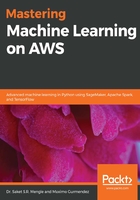
Prior probability
The prior probability is the overall probability of the event in the dataset. In our example, this would be the overall probability that it snows in the dataset. Prior probability is important in cases where the datasets are unbalanced, that is, the number of instances of one class variable in the dataset is significantly higher than the other. This leads to bias in the likelihood variable. Prior probabilities are used to renormalize these probabilities by taking the bias in the dataset into account. For example, in our dataset, the prior probability of a snow event is 30% and the prior probability of it not snowing is 70%. The probability of cloudy conditions when it snows is 66%, while the likelihood of cloudy conditions when it does not snow is 42.8%.
However, by taking the prior probabilities into account, although cloudy conditions are more likely when it snows than when it does not, after multiplying the priors, the posterior probability of snow when it is cloudy is 19% and the probability of not snowing when it is cloudy is 30%. By multiplying the prior probabilities to the likelihood events, we inform our posterior probability that there is a higher probability of it not snowing than snowing.